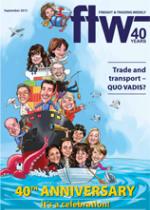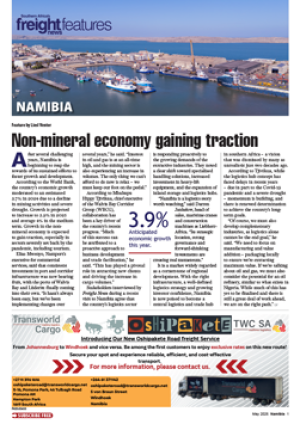When asked for his
predictions of the
future of shipping,
Ron Frick, MD of
DAL Agency, suggested to FTW
that such crystal ball gazing was
pure speculation.
“It has to be based on the trends
we see today, and how they could
develop further into the future,”
he said. “This, of course, is pure
conjecture.”
But pushed to gaze, Frick added
that the oversupply of container
vessels was predicted to extend to
2016 or 2017. “This depends on the
order book for new vessels being
placed in 2013/2014, and this
oversupply could be extended even
further.”
But he noted that alliances, such
as the development announced by
the Big Three container operators –
Maersk, MSC and CMA-CGM – of
the P3 alliance was an attempt to
reduce the oversupply.
“The three lines,” he said, “have
agreed to establish a long-term
operational alliance on East-West
trades. The aim is to trim the
number of vessels on their three
routes by improving and optimising
operations and service offerings.
And it will be extended to the
Trans-Pacific and Trans-Atlantic
trades, if the model works on the
Asia-Europe route.”
An attempt to meet forthcoming
emission control regulations,
and reduce fuel usage and cost,
is another must for the future,
according to Frick.
“We will undoubtedly see vessel,
engine, fuel and container design
making use of latest materials
to reduce weight and improve
fuel efficiency,” he said. “While
at the same time they will be
complying with the consumers’ and
governments’ demands for a cleaner
and safer environment.”
The picture in his crystal ball
also portrays a tightening-up of
vessel and port security. Added to
that Frick sees shippers having to
take more responsibility for the
accurate declaration of the weight
and type of cargo they load into the
containers.
“This, with the benefit of X-ray
technology, will eventually be
verified and reported electronically
as the cargo enters and leaves the
ports.”
Cargo tracking is also
something that, in the relatively
near future, will become even
more sophisticated. Said Frick:
“Container tracking devices will be
on board every container, giving
real time monitoring by means of
geo-positioning.”
The introduction of the ultra
large container vessels (ULCVs),
the likes of the Triple E class
introduced by Maersk with
18 000 TEU capacity, and bigger
in the future, will lead to landside
problems. “The ports they call at
will have added strain on inland
infrastructure,” said Frick. “This
will be in terms of container
handling facilities and the ability
to move the volumes loaded and
discharged by the mega ships into
the hinterland effectively by rail,
road and barge or a combination of
the three modes.
“These challenges will be solved
through major
investments
in ports and
infrastructure
development.”
Frick
also sees a
consolidation
of the number
of ship operators
in the future.
This as the global
economy fails to
keep pace with
the growth
in vessel
capacity.
“This,”
he said,
“will
possibly
lead to
some
casualties, as the banks that
finance these vessel and container
assets become more risk-averse.”
Added to this, according to Frick,
is the impact of politics on the
future of shipping. “Any hostilities,
for example, in the Middle East or
Central America could affect
the safe passage of vessels
through the Suez or Panama
canals,” he said.
Elsewhere, it might not have
such a throttling effect on
sea trade, but Frick could not
disagree with the fact that
politics running wild can have
an adverse effect on the free
flow of seafreight, and on
the insurance needed
to protect it
against the
extra costs
incurred.
INSERT & CAPTION
Container tracking devices
will be on board every
container, giving real time
monitoring by means of
geo-positioning.
– Ron Frick

